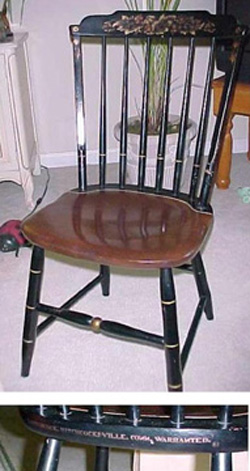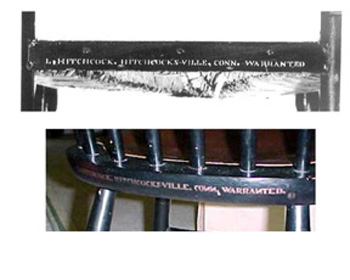
The first incarnation began in 1814 when 19-year-old Lambert Hitchcock of Chesire, Conn., was apprenticed to Silas Cheney (1776-1821) of Litchfield as a novice woodworker. Cheney was the typical cabinetmaker of the period turning out well-made examples of Federal sideboards and fancy painted chairs that caught young Hitchcock’s attention. While apprenticed to Cheney he became familiar with the work of Eli Terry, the famous clockmaker and inventor. Terry had formed a partnership with Seth Thomas and his son, also named Seth Thomas, to produce the components of wooden clock works in an assembly line fashion. This little trick stuck in Hitchcock’s mind as he mapped his future.
In 1818 Hitchcock completed his apprenticeship and moved to a tiny sawmill community in the township of Barkhamsted known as Fork-of-the-Rivers at the junction of the Farmington and Still rivers. He found employment in the local sawmill, which was owned by some family friends and settled in. He “homesteaded” a small room at the back of the mill and after tapping into the mill’s power source from the river he began to manufacture a small number of unfinished individual chair components. He sold these components to Yankee traders who sold them to mercantile stores as replacement parts for broken chairs. Business was good and demand soon outstripped his ability to meet it by himself. He hired some help to make the parts and began to expand his market, shipping chair components as far away as Charleston, S.C. He eventually graduated to making complete unfinished chairs in the “knockdown” stage ready to ship as unassembled kits for the do-it-yourself customers of the mercantile trade.
But Eli Terry still lurked in Hitchcock’s long-term plans and he began to lay the groundwork for a company that made and finished complete chairs of his own design. In 1820 he acquired a wooden two-story building nearby and began his dream of making chairs. The chair he made was based loosely on the Sheraton style of the period, but it also included elements from Empire klismos chairs with a few pointers from the popular “Baltimore” chairs. And most importantly the Eli Terry model of an assembly line was put into place with manufactured components combined by workers who performed only that one operation or a very limited number of operations. He was about 80 years ahead of Henry Ford. The chairs included no carvings of any sort and a minimum of hand painting to speed up the process.
The raw assembled frames were painted black or dark green and received a first coat of clear finish. While the finish was still slightly tacky Hitchcock borrowed the newly developed British technique of “stenciling” to richly decorate the otherwise rather plain chairs. Using a variety of metal stencils, as many as five different ones on a single chair, different colors of metallic powders were applied by brush to produce the mostly floral designs seen on the ubiquitous “Hitchcock” chair of the 1820s. To further reduce the cost Hitchcock used laborers from a nearby prison to weave cane and rush seats for his chairs.
Having decided early in the process to produce a reliable, fashionable seating platform for the average family at a reasonable cost, he priced his early chairs ranging from $.49 to $1.50. They were a hit and the factory was soon shipping chairs all over the East and Midwest as well as to the South. Since he employed over 100 men at the height of the operation, most of the male population of the town and the area, the town changed its name to Hitchcocksville in 1821 in honor of its largest employer. By 1825 Lambert Hitchcock was ensconced in a new three story brick building that turned out 300 chairs a week. He also was marking his chairs with the now famous “L. HITCHCOCK, HITCHCOCKS-VILLE, CONN. WARRANTED” stenciled across the back of the seat rail.
But even that level of success was no guarantee of lifelong fortune and fame. A series of events combining some bad luck with some bad business planning forced Hitchcock into receivership in 1829 and worked stopped until 1830. He was forced to take on his brother-in-law, Arba Alford, as a partner in 1832 and the name of the business was changed to Hitchcock, Alford & Co. It is the signature of this company that first incorporated the backward “N” in “CONN” and “WARRANTED.” The backward lettering was never used with the original “L. HITCHCOCK” logo. Apparently the backward lettering was an accident, but since most of the workforce was illiterate no one noticed for a long time.
The partnership was dissolved in 1843 and Hitchcock moved his business interests to Unionville, but no chairs were ever made there. He died in 1852 with more liabilities than assets and his estate was declared insolvent. In 1865 the original town even changed its name from Hitchcocksville to Riverton. It was a modest end indeed for a man who made such an important mark on American furniture manufacturing.
But it was not the end of the story. In 1946 just after the end of World War II the owner of several shoe stores decided to go “a-fishing” as he called it, in northwestern Connecticut. He arrived at the Riverton Inn looking forward to do some fly-fishing in the Farmington River. What he found instead was a decrepit old brick factory near the river that caught his attention. It had been used for some business or another until the 1920s but there was no doubt it was the three-story factory built by Lambert Hitchcock in 1825. Sifting through local sources he assembled the Hitchcock story and became fascinated. He realized that he even owned a forgotten Hitchcock type chair received as a wedding present.
By October of 1946 the former shoe salesman named John Tarrant Kenney had formed a Connecticut corporation named the Hitchcock Chair Co. with himself, his wife and a friend as shareholders. They signed a lease-purchase agreement on the old factory and started the long reopening process, greatly hindered by the wartime shortages that still affected much of America. By the fall of 1948 Kenney delivered the first order of 150 chairs made in the original factory to a furniture store in Hartford. The chairs resembled the original chairs as much as possible with recreated stencils and some ancient machinery. After a price adjustment the entire stock of new chairs sold out in one day with orders for many more. What the chairs did not have however was the stenciled name on the seat because Kenney did not own the rights to the name – yet.
Those rights were acquired in 1952, exactly 100 years after Hitchcock died. From then on the new furniture carried the trademark “L. HITCHCOCK. HITCHCOCKS-VILLE.CONN.WARRATED.®” Since this particular signature did not include the backward “N” in 1825, Kenney made sure that the two trademarks would never be confused by making the “N’s” in the new logo backward and included the registered mark on the new logo. He added one more distinctive mark to make doubly sure there was never any confusion. On chairs with solid wood seats the initials of the new company, “HCC”, were stamped into the wood.
Over the next 50-plus years the Hitchcock Chair Co. achieved and maintained a solid reputation for high quality merchandise, much of it hand turned and hand assembled. While the company introduced many new innovative styles and forms over the years, homage was always reserved for the original stenciled decorations and traditional paint colors.
Production ceased in May 2006, the victim of less expensive Asian imports. The assets of the Hitchcock Chair Co., including 200 lots of finished product as well as all woodworking machinery, furniture and fixtures, were sold at auction in New Hartford to a group of eager bidders. All of the assets except one that is. The coveted trademark was not sold at that auction. There was talk of a later sale but nothing has transpired yet. If the trademark is sold and the name somehow revived it won’t be the first time in American furniture making history. Heywood-Wakefield filed for bankruptcy in 1981 and the assets were dispersed. The trademark was acquired by a start-up company in Miami in 1985, which now produces a line of very credible H-W products right down to the black eagle logo.
Perhaps the Hitchcock line will rise again in the American furniture tradition.
ADDITIONAL IMAGES OF NOTE



